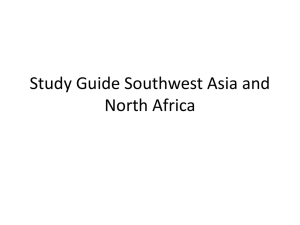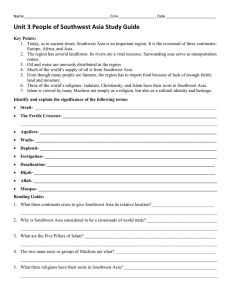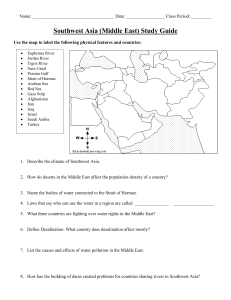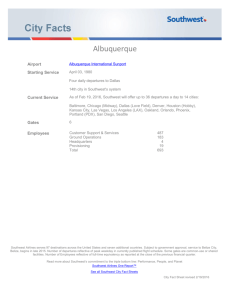Background
advertisement
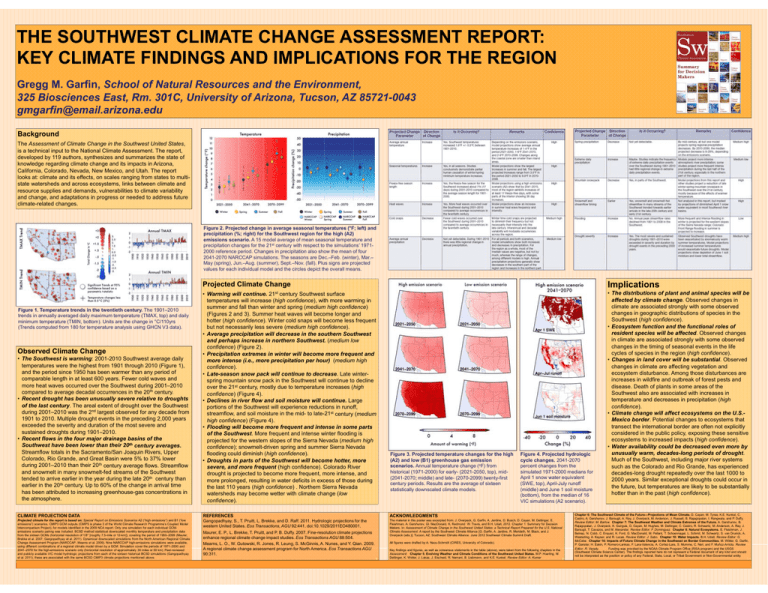
THE SOUTHWEST CLIMATE CHANGE ASSESSMENT REPORT: KEY CLIMATE FINDINGS AND IMPLICATIONS FOR THE REGION Gregg M. Garfin, School of Natural Resources and the Environment, 325 Biosciences East, Rm. 301C, University of Arizona, Tucson, AZ 85721-0043 gmgarfin@email.arizona.edu Background The Assessment of Climate Change in the Southwest United States, is a technical input to the National Climate Assessment. The report, developed by 119 authors, synthesizes and summarizes the state of knowledge regarding climate change and its impacts in Arizona, California, Colorado, Nevada, New Mexico, and Utah. The report looks at: climate and its effects, on scales ranging from states to multistate watersheds and across ecosystems, links between climate and resource supplies and demands, vulnerabilities to climate variability and change, and adaptations in progress or needed to address future climate-related changes. Figure 2. Projected change in average seasonal temperatures (°F; left) and precipitation (%; right) for the Southwest region for the high (A2) emissions scenario. A 15 model average of mean seasonal temperature and precipitation changes for the 21st century with respect to the simulations’ 19712000 reference period. Changes in precipitation also show the mean of four 2041-2070 NARCCAP simulations. The seasons are Dec.–Feb. (winter), Mar.– May (spring), Jun.–Aug. (summer), Sept.–Nov. (fall). Plus signs are projected values for each individual model and the circles depict the overall means. Figure 1. Temperature trends in the twentieth century. The 1901–2010 trends in annually averaged daily maximum temperature (TMAX, top) and daily minimum temperature (TMIN, bottom). Units are the change in °C/110yrs (Trends computed from 180 for temperature analysis using GHCN V3 data). Observed Climate Change • The Southwest is warming: 2001-2010 Southwest average daily temperatures were the highest from 1901 through 2010 (Figure 1), and the period since 1950 has been warmer than any period of comparable length in at least 600 years. Fewer cold waves and more heat waves occurred over the Southwest during 2001–2010 compared to average decadal occurrences in the 20th century. • Recent drought has been unusually severe relative to droughts of the last century. The areal extent of drought over the Southwest during 2001–2010 was the 2nd largest observed for any decade from 1901 to 2010. Multiple drought events in the preceding 2,000 years exceeded the severity and duration of the most severe and sustained droughts during 1901–2010. • Recent flows in the four major drainage basins of the Southwest have been lower than their 20th century averages. Streamflow totals in the Sacramento/San Joaquin Rivers, Upper Colorado, Rio Grande, and Great Basin were 5% to 37% lower during 2001–2010 than their 20th century average flows. Streamflow and snowmelt in many snowmelt-fed streams of the Southwest tended to arrive earlier in the year during the late 20th century than earlier in the 20th century. Up to 60% of the change in arrival time has been attributed to increasing greenhouse-gas concentrations in the atmosphere. CLIMATE PROJECTION DATA Projected climate for the report is based on: Special Report on Emissions Scenarios A2 (“high emissions”) and B1 (“low emissions”) scenarios. CMIP3 GCM outputs (CMIP3 is phase 3 of the World Climate Research Programme’s Coupled Model Intercomparison Project), for models identified in the 2009 NCA report. Only one simulation for each individual GCMemissions scenario pairing was included. BCSD method statistical downscaled monthly temperature and precipitation data from the sixteen GCMs (horizontal resolution of 1/8° [roughly 7.5-mile or 12-km]), covering the period of 1950–2099 (Maurer, Brekke et al. 2007; Gangopadhyay et al. 2011). Dynamical downscaled simulations from the North American Regional Climate Change Assessment Program (NARCCAP; Mearns et al. 2009). Nine NARCCAP high-emissions simulations were available, using different combinations of a regional climate model driven by a GCM. Simulation cover the periods of 1971–2000 and 2041–2070 for the high-emissions scenario only (horizontal resolution of approximately 30 miles or 50 km). Peer-reviewed and publicly available VIC model hydrologic projections from each of the sixteen historical BCSD simulations (Gangopadhyay et al. 2011); these are associated with the same BCSD CMIP3 climate projections mentioned above. Projected Climate Change Implications • Warming will continue. 21st century Southwest surface temperatures will increase (high confidence), with more warming in summer and fall than winter and spring (medium high confidence) (Figures 2 and 3). Summer heat waves will become longer and hotter (high confidence). Winter cold snaps will become less frequent but not necessarily less severe (medium high confidence). • Average precipitation will decrease in the southern Southwest and perhaps increase in northern Southwest. (medium low confidence) (Figure 2). • Precipitation extremes in winter will become more frequent and more intense (i.e., more precipitation per hour) (medium high confidence). • Late-season snow pack will continue to decrease. Late winterspring mountain snow pack in the Southwest will continue to decline over the 21st century, mostly due to temperature increases (high confidence) (Figure 4). • Declines in river flow and soil moisture will continue. Large portions of the Southwest will experience reductions in runoff, streamflow, and soil moisture in the mid- to late-21st century (medium high confidence) (Figure 4). • Flooding will become more frequent and intense in some parts of the Southwest. More frequent and intense winter flooding is projected for the western slopes of the Sierra Nevada (medium high confidence); snowmelt-driven spring and summer Sierra Nevada flooding could diminish (high confidence). • Droughts in parts of the Southwest will become hotter, more severe, and more frequent (high confidence). Colorado River drought is projected to become more frequent, more intense, and more prolonged, resulting in water deficits in excess of those during the last 110 years (high confidence) . Northern Sierra Nevada watersheds may become wetter with climate change (low confidence). • The distributions of plant and animal species will be affected by climate change. Observed changes in climate are associated strongly with some observed changes in geographic distributions of species in the Southwest (high confidence). • Ecosystem function and the functional roles of resident species will be affected. Observed changes in climate are associated strongly with some observed changes in the timing of seasonal events in the life cycles of species in the region (high confidence). • Changes in land cover will be substantial. Observed changes in climate are affecting vegetation and ecosystem disturbance. Among those disturbances are increases in wildfire and outbreak of forest pests and disease. Death of plants in some areas of the Southwest also are associated with increases in temperature and decreases in precipitation (high confidence). • Climate change will affect ecosystems on the U.S.Mexico border. Potential changes to ecosystems that transect the international border are often not explicitly considered in the public policy, exposing these sensitive ecosystems to increased impacts (high confidence). • Water availability could be decreased even more by unusually warm, decades-long periods of drought. Much of the Southwest, including major river systems such as the Colorado and Rio Grande, has experienced decades-long drought repeatedly over the last 1000 to 2000 years. Similar exceptional droughts could occur in the future, but temperatures are likely to be substantially hotter than in the past (high confidence). REFERENCES Gangopadhyay, S., T. Pruitt, L. Brekke, and D. Raff. 2011. Hydrologic projections for the western United States. Eos Transactions, AGU 92:441. doi:10.1029/2011EO480001. Maurer, E. P., L. Brekke, T. Pruitt, and P. B. Duffy. 2007. Fine-resolution climate projections enhance regional climate change impact studies. Eos Transactions AGU 88:504. Mearns, L. O., W. Gutowski, R. Jones, R. Leung, S. McGinnis, A. Nunes, and Y. Qian. 2009. A regional climate change assessment program for North America. Eos Transactions AGU 90:311. Figure 3. Projected temperature changes for the high (A2) and low (B1) greenhouse gas emission scenarios. Annual temperature change (oF) from historical (1971-2000) for early- (2021-2050, top), mid(2041-2070; middle) and late- (2070-2099) twenty-first century periods. Results are the average of sixteen statistically downscaled climate models. Figure 4. Projected hydrologic cycle changes. 2041-2070 percent changes from the simulated 1971-2000 medians for April 1 snow water equivalent (SWE, top), April-July runoff (middle) and June 1 soil moisture (bottom), from the median of 16 VIC simulations (A2 scenario). ACKNOWLEDGMENTS The material in this poster was excerpted from: J. Overpeck, G. Garfin, A. Jardine, D. Busch, D. Cayan, M. Dettinger, E. Fleishman, A. Gershunov, Gl. MacDonald, K. Redmond W. Travis, and B.H. Udall, 2012. Chapter 1: Summary for Decision Makers. In: Assessment of Climate Change in the Southwest United States: a Technical Report Prepared for the U.S. National Climate Assessment. A report by the Southwest Climate Alliance [G. Garfin, A. Jardine, R. Merideth, M. Black, and J. Overpeck (eds.)]. Tucson, AZ: Southwest Climate Alliance. June 2012 Southwest Climate Summit Draft. All figures were drafted by A. Nacu-Schmidt (CIRES, University of Colorado). Key findings and figures, as well as consensus statements in the table (above), were taken from the following chapters in the Assessment: Chapter 5: Evolving Weather and Climate Conditions of the Southwest United States. M.P. Hoerling, M. Dettinger, K. Wolter, J. Lukas, J. Eischeid, R. Nemani, B. Liebmann, and K.E. Kunkel. Review Editor: A. Kumar Chapter 6: The Southwest Climate of the Future—Projections of Mean Climate. D. Cayan, M. Tyree, K.E. Kunkel, C. Castro, A. Gershunov, J. Barsugli, A. Ray, J. Overpeck, M. Anderson, J. Russell, B. Rajagopalan, I. Rangwala, and P. Duffy. Review Editor: M. Barlow. Chapter 7: The Southwest Weather and Climate Extremes of the Future. A. Gershunov, B. Rajagopalan, J. Overpeck, K. Guirguis, D. Cayan, M. Hughes, M. Dettinger, C. Castro, R. Schwartz, M. Anderson, A. Ray, J. Barsugli, T. Cavazos, and M. Alexander. Review Editor: F. Dominguez. Chapter 8: Natural Ecosystems. E. Fleishman, J. Belnap, N. Cobb, C. Enquist, K. Ford, G. MacDonald, M. Pellant, T. Schoennagel, L. Schmit, M. Schwartz, S. van Drunick, A. Westerling, A. Keyser, and R. Lucas. Review Editor: J. Sabo. Chapter 10: Water Impacts. B.H. Udall, Review Editor: G. McCabe. Chapter 16: Impacts of Future Climate Change in the Southwest on Border Communities. M. Wilder, G. Garfin, P. Ganster, H. Eakin, P. Romero-Lankao, F. Lara-Valencia, A. Cortez-Lara, S. Mumme, C. Neri, and F. Muñoz-Arriola. Review Editor: R. Varady. Funding was provided by the NOAA Climate Program Office (RISA program) and the USGS (Southwest Climate Science Center). The findings reported here do not represent a Federal document of any kind and should not be interpreted as the position or policy of any Federal, State, Local, or Tribal Government or Non-Governmental entity.
